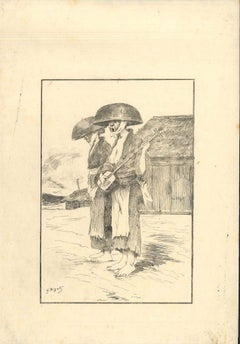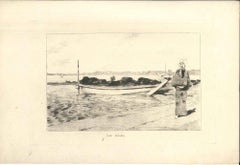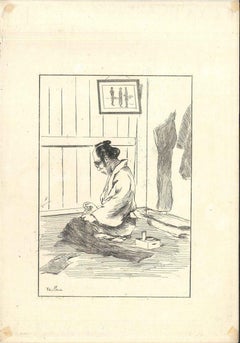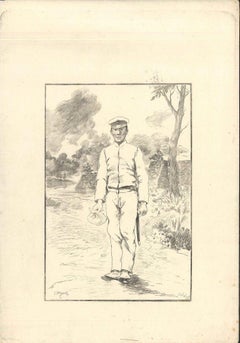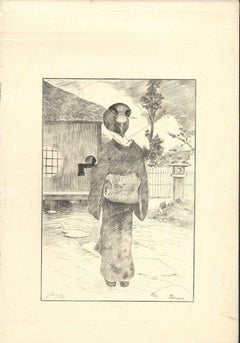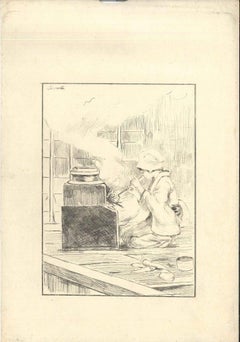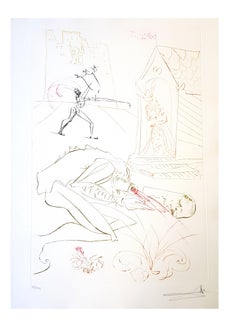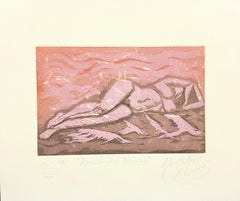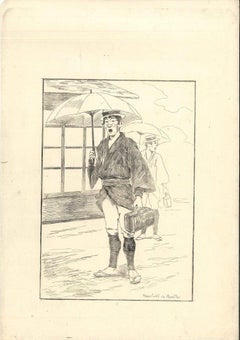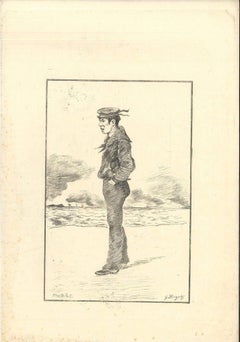George Ferdinand Bigot Figurative Prints
to
8
Overall Width
to
Overall Height
to
3
8
847
382
381
308
8
7
1
8
6
5
3
1
1
1
1
1
1
1
8
2
Artist: George Ferdinand Bigot
Untitled - Etching on Japan Paper by G. F. Bigot - Tokyo 1886
By George Ferdinand Bigot
Located in Roma, IT
Untitled is a drypoint on Japon paper, etched on leather by Georges Ferdinand Bigot (Paris, 1860 - 1927). From Croquis Japonais, a print suite of 21 drypoints published at the author...
Category
1880s Modern George Ferdinand Bigot Figurative Prints
Materials
Etching
Lac d'Imba - Etching on Japan Paper by G. F. Bigot - Tokyo 1886
By George Ferdinand Bigot
Located in Roma, IT
Lac D'Imba is a drypoint on Japon paper, etched on leather, by Georges Ferdinand Bigot (Paris, 1860 - 1927). From the portfolio Croquis Japonais, composed of 21 drypoints, published ...
Category
1880s George Ferdinand Bigot Figurative Prints
Materials
Etching
Tailleur - Etching on Japan Paper by G. F. Bigot - Tokyo 1886
By George Ferdinand Bigot
Located in Roma, IT
Tailleur is a drypoint on Japon paper etched on leather by Georges Ferdinand Bigot (Paris, 1860 - 1927). From Croquis Japonais, a print suite of 21 drypoints, a portfolio published at the author's expense in Tokyo in 1886.
In this modern artwork, an old sailor...
Category
1880s George Ferdinand Bigot Figurative Prints
Materials
Etching
Soldat - Original Etching on Japan Paper by G. F. Bigot - Tokyo 1886
By George Ferdinand Bigot
Located in Roma, IT
Soldat is an etching on Japon paper, etched on leather, realized by Georges Ferdinand Bigot (Paris, 1860 - 1927).
From Croquis Japonais, a print portfolio of 31 etchings, a collecti...
Category
1880s George Ferdinand Bigot Figurative Prints
Materials
Etching
Servante - Original Etching on Japan Paper by G. F. Bigot - Tokyo 1886
By George Ferdinand Bigot
Located in Roma, IT
Servante is an etching on Japon paper, etched on leather, made by George Ferdinand Bigot (Paris, 1860 - 1927).
From Croquis Japonais, a print suite of 31 etchings, a collection publ...
Category
1880s Modern George Ferdinand Bigot Figurative Prints
Materials
Etching
La Servante - Original Etching on Japan Paper by G. F. Bigot - Tokyo 1886
By George Ferdinand Bigot
Located in Roma, IT
La Servante is a drypoint on Japon paper, etched on leather by the modern artist Georges Ferdinand Bigot (Paris, 1860 - 1927). From the print series Croquis Japonais, a collection ma...
Category
1880s George Ferdinand Bigot Figurative Prints
Materials
Etching
Gendarme - Original Etching on Japan Paper by G. F. Bigot - Tokyo 1886
By George Ferdinand Bigot
Located in Roma, IT
Gendarme is a drypoint on Japon paper, etched on leather by Georges Ferdinand Bigot (Paris, 1860 - 1927).
From Croquis Japonais, a print suite of 21 drypoints, a collection published at the author's expense in Tokyo in 1886.
Titled by "the caricaturist of the Meiji era", Georges Bigot, on plate on the lower right margin.
Overall very good conditions, except for some usual yellowing of paper on the edges.
In this beautiful print, a Japanese military...
Category
1880s Modern George Ferdinand Bigot Figurative Prints
Materials
Etching
Bonzes - Etching on Japan Paper by G. F. Bigot - Tokyo 1886
By George Ferdinand Bigot
Located in Roma, IT
Bonzes is a drypoint on Japon paper, etched on leather, made by Georges Ferdinand Bigot (Paris, 1860 - 1927). From Croquis Japonais, a print suite of 21 drypoints, a collection published at the author's expense in Tokyo in 1886.
Titled on plate on the lower right margin, signed on plate on the lower left "G. Bigot".
Overall very good conditions, except for some sporadic minor stains on the lower margin.
In this modern art print, two bonzes are represented during a Buddhist religious ceremony. The black and gray palette is very broad.
Bónzo, literally "master of the cell" or, according to others, bōshi, i.e. "master of the law", is the title given to religious men...
Category
1880s George Ferdinand Bigot Figurative Prints
Materials
Etching
Related Items
Salvador Dali - Fight Before la Dame - Original Handsigned Etching
By Salvador Dalí
Located in Collonge Bellerive, Geneve, CH
Salvador Dali - Original Handsigned Etching
From La Quête du Graal
Dimensions: 45 x 33 cm
Handsigned
Edition: 38/100
(from the rare deluxe suite aside from the standard edition)
Cat...
Category
1970s Surrealist George Ferdinand Bigot Figurative Prints
Materials
Etching
$1,888
H 17.72 in W 13 in D 0.4 in
"Discovering your landscapes" 2007 Original Engraving Signed Figurative 12x10in
Located in Miami, FL
Alberto"El Cuervo" Bustillos (Mexico, 1950)
'Descubrir tus paisajes', 2007
etching, aquatint on paper Deponte 300 g.
12.3 x 10.3 in. (31 x 26 cm.)
ID: CUR-108
Unframed
Category
Early 2000s Contemporary George Ferdinand Bigot Figurative Prints
Materials
Etching, Aquatint, Engraving
John Taylor Arms, Study in Stone, Cathedral of Ourense
By John Taylor Arms
Located in New York, NY
John Taylor Arms was known for making such finely drawn etchings that commercial tools were not good enough: He regularly used sewing needles with corks ...
Category
Mid-20th Century American Realist George Ferdinand Bigot Figurative Prints
Materials
Etching
Une Escale au Brasil (A Stopover in Brazil)
By Charles Dufresne
Located in New York, NY
Charles Dufresne (1876-1938), Une Escale au Brasil (A Stopover in Brazil), etching and drypoint, c. 1920, signed in pencil lower right margin and inscribed “epreuve de artist” lower ...
Category
1920s Modern George Ferdinand Bigot Figurative Prints
Materials
Drypoint, Etching
Cathedral de Saint Julien le Mans
By John Taylor Arms
Located in Middletown, NY
Etching on antique cream laid paper with a deckle edge, 9 1/8 x 9 3/4 inches (232 x 248 mm); sheet 12 1/8 x 12 3/4 inches (307 x 323 mm), full margins. Signed and dated in pencil in ...
Category
Early 20th Century American Modern George Ferdinand Bigot Figurative Prints
Materials
Handmade Paper, Laid Paper, Etching
The New Pupil /// Antique Modern Female Artist Etching Child Children Figurative
By Eileen Soper
Located in Saint Augustine, FL
Artist: Eileen Alice Soper (English, 1905-1990)
Title: "The New Pupil"
*Signed by Soper in pencil lower right
Year: 1925
Medium: Original Etching on unbranded white wove paper
Limite...
Category
1920s Modern George Ferdinand Bigot Figurative Prints
Materials
Etching, Intaglio
Advice
By Walt Kuhn
Located in New York, NY
Walt Kuhn (1877-1949), Advice, etching and drypoint, 1915, signed in pencil lower right and titled lower left. In generally good condition but obviously a proof impression, with marg...
Category
1910s American Modern George Ferdinand Bigot Figurative Prints
Materials
Drypoint, Etching
Les Faneuses
By Camille Pissarro
Located in Washington, DC
Artist: Camille Pissarro
Title: Les Faneuses
Portfolio: l'Histoire des Peintres Impressionistes
Medium: Etching on cream laid paper
Date: 1906
Edition: 1000
Frame Size: 19 1/2" x 17"...
Category
Early 1900s Modern George Ferdinand Bigot Figurative Prints
Materials
Etching
André Masson "La jambe déguisée" 1975 Signed Etching w/ Aquatint, Edition of 50
By André Masson
Located in Miami, FL
ANDRÉ MASSON – "LA JAMBE DÉGUISÉE"
⚜ Etching with Aquatint ⚜ Hand Signed Lower Right ⚜ Numbered 23/50 ⚜ Conservation Frame
SURREAL FIGURATION AND AUTOMATIC LINE
Created in 1975, La ...
Category
1970s Surrealist George Ferdinand Bigot Figurative Prints
Materials
Etching, Aquatint
$3,850 Sale Price
30% Off
H 26.125 in W 23.375 in D 2.25 in
Maternité / Motherhood I: Honte / Disgrace
By Marc Chagall
Located in Santa Monica, CA
MARC CHAGALL (1887 – 1985)
MATERNITE, 1926. Motherhood I: Honte / Disgrace (Kornfeld 65, Cramer 5, Sorlier, p. 20-21
Etching, Frontispiece from Maternite Au Sans Pareil, Paris, 1926. Marcel Arland, illustrated by Marc Chagall with five original etchings this being one of the five. Image size: 5 5/8 x 4 1/8. 1130 unsigned impressions on various papers. The story begins with a young woman being shunned by the whole village because she had given birth to a child and left its dead body...
Category
1920s Modern George Ferdinand Bigot Figurative Prints
Materials
Etching
LE BALLON VERT
By Graciela Rodo Boulanger
Located in Portland, ME
Rodo-Boulanger, Graciela. LE BALLON VERT. Lublin 20. Etching with aquatint in colors, 1967. Edition of 100. Numbered 31/100 and signed in pencil. 21 1/8 x 17...
Category
1960s Modern George Ferdinand Bigot Figurative Prints
Materials
Etching, Aquatint
Le Collier de Lussie
By Marie Therese Vacossin
Located in Kansas City, MO
Marie Thérèse Vacossin
Le Collier de Lussie
Color etching on hand-made paper
Year: 1971
Signed, numbered, dated and titled by hand
Edition: 8
Size: 8.3 × 11.6 on 22.0 × 14.8 inches
...
Category
1970s Modern George Ferdinand Bigot Figurative Prints
Materials
Handmade Paper, Etching
Previously Available Items
Merchand de Remèdes- Original Etching on Japan Paper by G. F. Bigot - Tokyo 1886
By George Ferdinand Bigot
Located in Roma, IT
Merchant de remèdes is a drypoint on Japon paper, etched on leather by the artist Georges Ferdinand Bigot (Paris, 1860 - 1927).
From Croquis Japonais, a print collection of 21 drypo...
Category
1880s George Ferdinand Bigot Figurative Prints
Materials
Etching
H 11.82 in W 8.08 in D 0.04 in
Matelot - Original Etching on Japan Paper by G. F. Bigot - Tokyo 1886
By George Ferdinand Bigot
Located in Roma, IT
Matelot is a drypoint on Japon paper, etched on leather, by Georges Ferdinand Bigot (Paris, 1860 - 1927).
From a print suite of 21 drypoints, called Croquis Japonais, a collection p...
Category
1880s George Ferdinand Bigot Figurative Prints
Materials
Etching
H 11.82 in W 8.08 in D 0.04 in
George Ferdinand Bigot figurative prints for sale on 1stDibs.
Find a wide variety of authentic George Ferdinand Bigot figurative prints available for sale on 1stDibs. You can also browse by medium to find art by George Ferdinand Bigot in etching and more. Much of the original work by this artist or collective was created during the 19th century and is mostly associated with the modern style. Not every interior allows for large George Ferdinand Bigot figurative prints, so small editions measuring 9 inches across are available. Customers who are interested in this artist might also find the work of Alfred Grevin, Pierre Puvis de Chavannes, and Léopold Flameng. George Ferdinand Bigot figurative prints prices can differ depending upon medium, time period and other attributes. On 1stDibs, the price for these items starts at $195 and tops out at $279, while the average work can sell for $209.
Artists Similar to George Ferdinand Bigot
Paul Gavarni (Guillaume Sulpice Chevalier)
